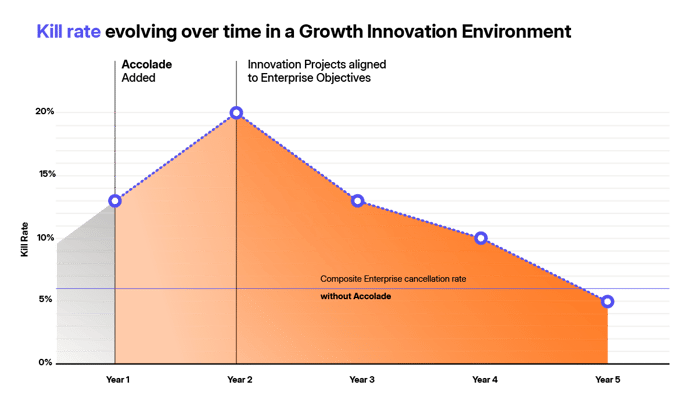Without a clear strategy, even a trip to the grocery store can go sideways. We pile in what looks promising: a mix of good intentions, impulse picks, and items destined to expire untouched. The fridge ends up full, but not necessarily useful.
Innovation portfolios often suffer the same fate. Lacking a structured approach, they fill up with scattered initiatives, hopeful punts, and legacy projects no one wants to let go of.
That’s where growth innovation comes in, the equivalent of a well-planned meal strategy for your pipeline. It reshapes how you stock it (approve projects), how you consume it (allocate resources), and what you clear out (kill rate). At first, you throw out a lot. But over time, waste goes down and everything in your portfolio earns its shelf space.
Every innovation portfolio has projects that get terminated or shelved before reaching the market. The percentage of products and projects that are shut down mid-development is known as a “kill rate,” and the sweet spot in an enterprise’s kill rate has been the topic of some debate.
The downsides of killing projects seem pretty intuitive. Most projects are launched on the basis of a good idea or opportunity, and shutting a project down early means the loss of invested resources and potential market value. On top of the opportunity cost, premature termination can impact the morale of those who feel a sense of ownership, responsibility, and personal investment.
But it’s essential to keep in mind the potential upsides to a higher kill rate:
- It demonstrates a selective strategic process
A higher kill rate demonstrates that an organization is evaluating projects through a more strategic lens than simply whether the idea is sound.
- It's indicative of triage and prioritization
Resources are finite. By terminating less promising projects early, enterprises can allocate resources to more promising initiatives, increasing the success rate for the entire portfolio. - It illustrates an ability to course-correct
A successful company is willing to change direction when necessary. This adaptability is essential in a world where market conditions and customer needs change rapidly. - It exemplifies true innovation
Innovation always includes some degree of trial and error, and a high kill rate can demonstrate that a company is willing to take risks. But by judiciously identifying and terminating unsuccessful projects, they learn from their mistakes and move on to more promising opportunities.
While we pointed out that terminating projects can have a morale cost, the opposite can also be true. Projects that don’t have the enterprise’s complete confidence can also negatively impact morale. No one wants to be associated with a project that drains time and resources and ultimately fails to perform as projected.
A high kill rate can be positive, demonstrating a company's selectivity, prioritization, adaptability, and willingness to innovate. However, balancing these benefits with the potential downsides is also essential.
Ultimately, there may be more happening with kill rates than meets the eye, as we discovered in our Total Economic Impact of Accolade report.
The growth innovation kill rate spike phenomenon
Forrester Consulting studied the total economic impact and return of investment that companies might expect from using Accolade, our innovation management software. They interviewed six representatives with Accolade experience, and then aggregated the interviewees’ experiences, combining the results into a single composite organization, a globally operating manufacturer with $25 billion in annual revenue.
Their findings about Accolade users included:
- Increased revenue from innovative products by 25% from higher innovation throughput and success rate
- Increased profit margin by 1 percentage point from product improvements
- A 15 percent acceleration in time to market
- A project budget savings of 10 percent and a bypass of 20 project manager FTEs.
One of the most provocative findings, however, concerned project terminations. When Forrester examined these six organizations, it found that growth innovation practices dramatically changed their project kill rate over five years.
An innovation applications administrator in manufacturing told Forrester, “I think prior to Accolade, we did not kill projects. We liked to hold onto them forever. Now, we’re starting to see the benefit of ‘fail fast.’ So our kill percentage has gone from around 6 percent to 13 percent.”
Forrester found that the composite enterprise has a 6 percent cancellation rate on its projects without Accolade. Once the composite organization added Accolade, the kill rate increased to 13 percent in the first year and shot up to 20 percent in year two. But as innovation projects were brought into alignment with enterprise objectives, the kill rates started to come back down. In year three, 13 percent of projects were canceled. In the fourth year, that percentage dropped to 10 percent. By year five, that number dropped below pre-Accolade levels to 5 percent.

As innovation-heavy enterprises transition toward a growth innovation strategy, they can expect an initial spike in their kill rate, but eventually that figure will fall below their original kill rate.
Let’s examine why.
Groceries and growth innovation kill rates: an analogy
Growth innovation gives organizations a schematic for aligning their innovation portfolio with their business objectives. It changes how future projects are greenlit and impacts how we look at the projects currently in the pipeline. It’s very similar to the way a new diet affects one’s shopping habits and how they manage their pantries.
Without a strategy (in this analogy, a structured diet or meal plan), we often end up filling our fridge haphazardly. Even at our most budget-conscious, we throw things into our grocery carts on a whim. We walk the aisles, grabbing stuff a family member suggested, items on sale, or random ingredients for a meal we might want to make at a future date.
When we get home, we get that dopamine lift from having a full fridge. But we might not have a firm grasp on our inventory. We soon discover that we bought stuff we already had on hand, and despite our full fridge, we end up grazing on the stuff directly in our line of sight. Meanwhile, produce in the lettuce crisper is going bad, and we have no idea how many of our condiments and other items are long past their expiration date.
One day, we decide to start that new diet we’ve been putting off, so, before we go grocery shopping, we sit down and make a meal plan for the week. When we hit the grocery store, we’re on a mission to pick up items that align with our diet plan. We end up coming home with quite a bit fewer groceries than usual, but we shopped much more efficiently—and, more importantly, we’ll end up eating the items we purchased.
The next part of that process is weeding out the random stuff taking up space in the fridge and is out of alignment with our meal plan. The first order of business is throwing out the food that’s already spoiled or is past its expiration date. Next, we toss items that don’t align with our new diet. It makes sense that a diet and meal plan would impact our shopping habits, but taking this plan seriously impacts our relationship with the food in our fridge. Getting rid of the stuff working against us is a critical part of the process.
Even though our diet and meal plans lead to an initial bump to the food we toss, eventually we’re throwing out less food than we used to. Our fridge might not be as full as it once was, but everything serves a purpose and gets used. We ultimately save money (and time) and eat a lot healthier.
An initial kill rate bump can be a net positive
Similar to the impact a diet and meal plan have on our pantry management and future shopping habits, growth innovation changes how we assess our current innovation portfolio. It impacts the criteria for greenlighting projects and tells us which ones don’t align with our objectives and need to be scrapped—or at least put on hold.
For many organizations, simply completing an innovation project is often considered a win. But within a growth innovation framework, that’s only true if the completed project meets enterprise goals. We’re not simply checking in on projects to ensure that they’re on course to meet their deadlines, but also on track to hit their revenue targets. This means that we’re assessing our entire innovation pipeline for projects that aren’t making the grade, including:
- In the growth innovation strategy process
- In the portfolio auditing process
- In the data input process
- In the reporting process
As a growth innovation strategy is implemented, projects that consume resources but will not bring the organization closer to its goals must be weeded out. As the composite enterprise discovered, this will lead to an immediate spike in the kill rate as the most obvious projects are axed. And as managers weigh the merits of various projects, that spike can surge even higher in the following year.
But over time, the pipeline is put in order, and a more strategy-oriented way of getting projects into the pipeline is developed. New projects are greenlit based on their ability to contribute to current, planned, and candidate revenue streams that ladder up to meet enterprise objectives. Their existence is justified before they get underway, eventually lowering the kill rate below the pre-growth innovation threshold.
Sorting out your innovation portfolio
A spike in your kill rate isn’t inherently negative. It indicates you’re weeding out underperforming projects and refocusing resources on more critical activities, allowing for more efficient resource allocation and a better chance of hitting targets and achieving enterprise goals.
If you’re interested in putting together your own growth innovation strategy, check out “How to Craft a Growth Innovation Strategy.”
We’ve also put together an ebook to help you begin eliminating some of the dead weight in your portfolio. Download a copy of Purging Zombie Projects. It will help you strengthen your portfolio by identifying the projects that might require a little extra attention or need to be cut altogether.
Lastly, discover how Accolade’s data visibility gives managers an even better view of how their projects are performing against targets across the whole portfolio, and it’s the tool that drove up enterprise kill rates as unproductive projects were discontinued, and brought those rates back down as projects began to align with strategic objectives. Discover how Accolade can help you strengthen your innovation pipeline. Book a demo today.
